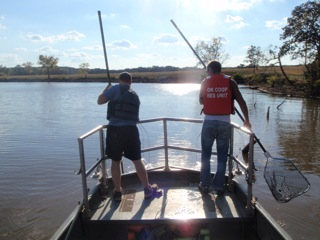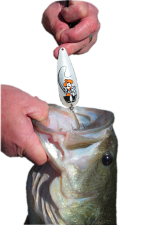Flathead Catfish Recruitment and Reproduction
Project personnel: Candice Miller, Dan Shoup

Angling for flathead catfish has become increasingly popular in the past decades, spurring a need for research on this relatively poorly studied species. In particular, little is known about the early life history of the species and factors affecting reproduction and recruitment. This is of particular importance to managers in locations where “noodling” or hand fishing allows capture of fish from spawning nests. The population consequences of this activity cannot be accurately assessed without information about the percentage of the population that reproduces in a given year and the factors that regulate recruitment of the newly-spawned year class (e.g., is year class formation strictly density dependent or does greater spawning production lead to larger year class formation). While the fact that hand fishing has been practiced for decades in Oklahoma clearly indicates it can be done sustainably, it is still important to understand how this activity relates to population dynamics (and reproduction in particular) to allow managers to set appropriate harvest regulations to maintain the highest quality flathead fishing opportunities possible.

We are conducting research in several southern reservoirs with varying flathead catfish densities to evaluate the reproductive biology of the species. We are particularly interested in the habitat required for successful reproduction, quantifying the fecundity of different sizes/ages of flathead catfish, and determining what proportion of the population actually spawns in a given year. By learning about these basic aspects of the reproductive biology of flathead catfish, we hope to determine the potential for enhancing population size by managing reproductive habitat and to provide information needed to set appropriate harvest regulations for the species.


